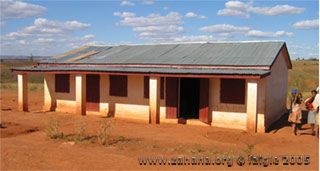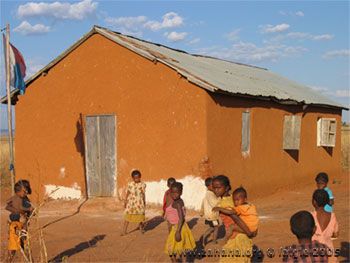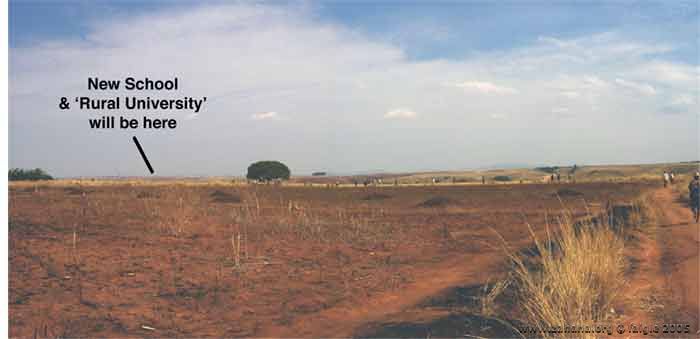To see photos of the new school built in 2005/2006/2007
A NEW SCHOOL FOR FIADANANA (our plans from 2005)
Schools in villages in Madagascar are traditionally one-story buildings with one or two rooms. A single teacher teaches all students in a room. Teachers either live in the community, or walk there for a neighboring community. The teachers salaries, often in the form of rice and housing, are commonly provided by a village community. While it is the declared goal of the Malagasy government to provide schooling for all children there are still many villages without a school, especially in remote areas. The picture shows a typical village school building as found anywhere in the country.

A
typical school in a village in Madagascar
The current (2005 pre-Zahana) school attendance
in Fiadanana
There are currently 150 children 5-15 years old and 550 children under
5 in Fiadanana. 27 of the children attend a public school in Ambohibary.
In the dry season this is a 2km (1.25 miles) walk each way, crossing
a river along the way. In the rainy season (that lasts five months,)
children have to walk for almost 15 km (9.3 miles) to cross the river
at the bridge. Consequently they miss school during the rainy season.
10 children walk from Fiadanana to Ambatomitsanganas public school,
more than 2 km away. The teacher is already overstretched teaching all
the students in this village, so the capacity for additional students
from Fiadanana is limited. Some of the parents had taken the initiative
and hired a teacher from neighboring Bevato to teach their 33 children
in Fiadanana. They had been using the Catholic Church building, but this
option is no longer available. The children not attending school stay
in the village and have nothing to do and are often left on their own.

The Catholic Church
building in Fiadanana
What would a school in Fiadanana mean for the village?
In the last community meeting in November 2005 a villager donated the land where the school will be built. Located a 5 minute walk from the village, it is at the northern edge of the village, an auspicious and ideal location for a learning center in Malagasy culture.

Picture of the future
schoolgrounds
Giving Fiadananas youth access to schooling in their own community for the first time will have a long lasting transformative impact on the community. Zahana will use a participatory learning approach, with Zahana representatives and teachers learning from the villagers as they learn from their counterparts. The scope of the school will go beyond traditional primary education for school age youth, providing tailor made education that addresses the needs of younger children and adults alike.
The Plan - Building the new schoolBuilding a school or the rural university for teaching
children and adults will require a proper building as well as outdoor education
areas. A simple bamboo fence, envisioned becoming a living fence over time,
with fruit trees and medicinal plants will surround the premises. There
will be a water hand pump and a solar water pasteurizer for clean, safe
drinking water next to the building. The school grounds are big enough
to accommodate a school garden.
Oriented on what people know the educational building will have at least
two rooms. The smaller room will be the more traditional school building
with benches for the school age youth and bigger room will serve as a multi-purpose
room for both, children under five years of age and adults alike. Simple,
but effective, innovative ideas will be included in its architectural design.
Clear plastic instead of corrugated iron in parts of the schools roof
serve as a skylight on rainy days, when the windows will have to be kept
closed. Mosquito nets in the windows (glass is not used anywhere in villages)
will help protect from the dangers of malaria.
An additional pavilion with an improved cook stove for nutritional classes
will need to be built on the school grounds. A separate building with 4
waterless toilets and a bathing room is located at the lowest point of
the school grounds, far away from the water pump. Such innovative s designs,
based on sound public health concepts, will introduce improved ideas of
commonly used facilities to the community by example.
Funding needs
As with the water, the community will actively be involved in building
this school. The villagers will provide as much as they can, by making
the bricks needed locally and contributing their labor to erect the school
and other buildings. Zahana will have to find the funding to provide and
pay for the roofing materials, wooden beams, doors, windows, nails, furniture
and other goods that cannot be obtained locally.
Zahana has committed to assist with the hiring and training of the teacher
and pay her or his salary for the first two years. After this initial phase,
providing for the teachers will become the communitys responsibility.
Young children and the rural university
Based on the villagers feedback a school is needed for the younger children
(before school age) where they learn basic life skills, such as how to
interact socially and politely with others and basic public health knowledge
like washing hands before eating as well as having a space to just be a
kid and play.
The name rural university has been chosen on purpose for older students
and adults alike. Most of them would never dream of attending a university
and the name will instill pride. It will become a place where people can
improve their knowledge in a setting that goes beyond the traditional secondary
education offered in the state run school system. Fattening of cattle was
a priority identified by the villagers. Such a topic needs to be included
in the rural universitys curriculum, as are other issues relating to farming,
income generation and health education. Protein deficiency, as a result
of malnutrition is a major health concern for Fiadananas children. The
cooking pavilion, as an extension of the rural university, will provide
hands-on nutritional education for parents and young mothers.
Teachers and curriculum
A specially trained and motivated teacher for Fiadanana is required. She
or he will be able to integrate concepts like project based learning and
orient the curriculum on the village reality while including the requirements
of basic education provided at state schools. Creating a school as a laboratory
for alternative styles of learning is an important component of this pilot
project for rural development. Zahana will be actively involved in hiring
and training of the future teacher.










